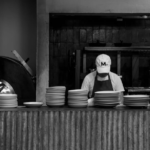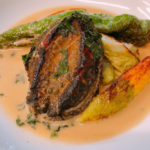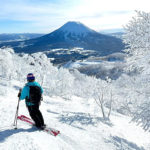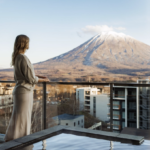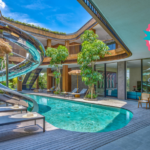Thinking about skiing in Japan for the first time? Say hello to Niseko, Japan’s most famous ski town that boasts legendary powder snow, an amazing après-ski scene and views of Mount Yotei that never get old.
Whether you’re going on your first run or a powder hound planning an epic trip, here’s your complete guide to experiencing the best of Niseko — when to go, what to pack, as well as where to stay, eat, explore.
#1 What’s the best time to visit Niseko?
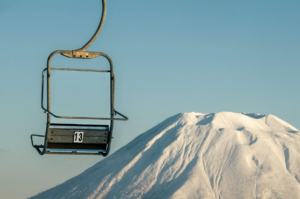
Niseko’s ski season typically runs from late November to early May, but the experience changes dramatically depending on when you visit. Whether you’re chasing untouched powder, family-friendly winter activities, or savouring the après-ski scene, here’s a breakdown of what each period offers.
Early Season: Late November to Mid-December
This is when the excitement starts building. Ski resorts, restaurants and shops begin opening gradually, and while not everything is operational yet, this is the time when you can score great deals on accommodation and passes. Snowfall starts to pile up from late November, perfectly timed for the official opening of ski resorts (PSA: Niseko United is scheduled to open on November 29, 2025 this year). Average base depths reach around 100–150cm by mid-December and there’s an average temperature of -5.5°C (22.1°F).
This is the perfect window for budget-conscious travellers and first-timers who want quieter slopes, shorter lift lines, and plenty of room to practice your turns. Keep in mind that night skiing and some mountain restaurants may not open until closer to Christmas.
Peak Season: Late December to February
This is when you’ll see what Niseko is famous for: the world’s best powder snow called ‘Japow’ (short for Japan powder). From Christmas through February, the mountains are blanketed in deep, dry powder averaging 15–20m of snowfall annually and an average temperature of -2.9°C (26.8°F) during this period. All four Niseko United resorts — Grand Hirafu, Hanazono, Niseko Village, and Annupuri — are in full swing, with all lifts, slopes and après-ski spots open.
Expect bustling nightlife in Hirafu Village, with lively izakayas and quite an international crowd. Don’t be surprised if you bump into someone from your city right in this alpine town! This is also prime time for night skiing, which is best done in Niseko. Gliding down perfectly groomed slopes under the glow of mountain floodlights is a must-try.
Because it’s peak season, be sure to book your accommodation, gear rentals, and lessons well in advance, even months ahead. Prices are higher, of course, but the snow conditions are at their absolute best.
Read also: 5 Stylish Properties in Japan For A White Christmas
Late Season: March to April
By March, the weather starts to warm up, but the fun doesn’t stop. This is when Niseko transitions into a spring skiing destination with softer snow, sunnier days, and fewer crowds. It’s also a great time for families and beginners since the slopes are less intimidating and the temperature hovers around -5°C to +2°C.
You’ll find more availability in restaurants, and accommodation rates start to dip. March and April also bring spectacular bluebird days: sunny, cloud-free weather that’s perfect for photos, relaxed skiing, or even backcountry tours for the adventurous travellers.
Snow typically lasts until early May at higher elevations, so you can still squeeze in some late-season runs if you time it right.
#2 What should you pack for a trip to Niseko?

Packing for Niseko is less about overloading your suitcase and more about layering for an experience. Think of it like dressing for adventure with style: thermals that move with you, a cosy mid-layer, and a waterproof outer that can handle both powdery snow and icy winds.
January mornings bite, so you’ll want your warmest gloves, a hat, and those yellow-lens goggles that make snowy days feel almost cinematic. Later in the season, the air softens and spring sun starts to warm the slopes, so lighter layers suffice, but a waterproof jacket is still essential.
Footwear is just as important. Whether you’re hopping between cafés in Hirafu or trudging through fresh snow to catch the first lift, sturdy walking boots that are both insulated and non-slip are a must. Don’t forget accessories: a scarf, neck gaiter, and thermal socks can transform a cold day into a comfortable one, letting you focus on carving turns instead of shivering.
For gear, you can either pack your own skis and board or rent from local shops like YamaSport, Rhythm Japan, or Niseko Sports — all of which provide top-quality equipment that feels almost new each season. Renting frees you to travel light and still hit the mountain fully prepared.
Read also: Powder Perfect: How Photographer Chad Clark Captures Hokkaido in Action
#3 How do I get to Niseko?

Niseko might feel like a world away — snow-capped, serene, and surrounded by quiet mountains — but getting here is surprisingly easy. Most travellers fly into New Chitose Airport (CTS) in Sapporo, the main gateway to Hokkaido. Cities like Sydney, Singapore, Hong Kong and Manila have direct flights to Sapporo during the winter season, but those living farther away may have to take an international flight into Tokyo (Narita or Haneda Airport) or Osaka (Kansai Airport) then transfer to a domestic leg to Sapporo.
From Sapporo, Niseko is about a two and a half hours drive away. It’s a scenic ride through sleepy towns and frosted forests that look straight out of a snow globe. If you’re travelling with family or a group, private transfers like SkyExpress offer private service right to your condo-hotel or chalet. For solo travellers or those who prefer a budget-friendly route, the Hokkaido Resort Liner and White Liner buses run regularly from the airport to Niseko-Hirafu.
Car rentals are also an option, though winter driving in Japan can be challenging if you’re not used to icy roads. It’s better to leave it to the pros and enjoy the ride!
#4 What kind of accommodation is available in Niseko?
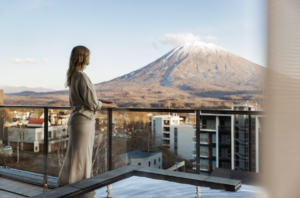
In Niseko, where you stay isn’t just about convenience, it’s about how you want to experience the mountain. Do you want to be steps away from the ski lifts, or tucked into a quiet corner where mornings begin with the sound of snow falling off branches?
If you want to be right in the heart of it all, Hirafu is the place to be. It’s the buzzing centre of Niseko, filled with cafés, restaurants, bars and boutiques. Here you’ll find The Maples Niseko, a slope-side property that offers ski-in, ski-out access and sleek modern interiors that feel like home.
A short stroll away is Niseko Kyo, a luxurious ski-in, ski-out property where contemporary design meets the essence of Japanese hospitality. With direct access to the Ace Family Run, private onsens in select residences, and refined interiors that blend natural wood and stone, it’s perfect for those who want both elegance and convenience right at the slopes.

For those who want to be away from the bustle but still perfectly accessible, Intuition Niseko is your best bet. Blending Japanese tranquillity with modern luxury, this condo-hotel has onsen baths, forest views, perfect for moments of stillness after a day on the slopes.
For those craving the privacy of a home-away-from-home, Niseko’s chalets offer the ultimate alpine experience, think spacious living areas, panoramic Mount Yotei views, and the warmth of your own fireplace after a day in the snow.
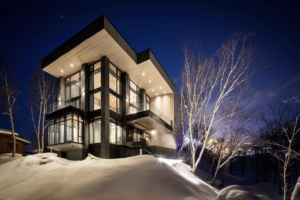
One of our favourite chalets is the stunning Corniche. This modern alpine retreat combines sleek architecture with the warmth of a mountain home, offering floor-to-ceiling windows overlooking Mount Yotei, a private onsen, and a cosy living area designed for après-ski evenings in style.
And if you’re looking to escape the crowds entirely, the quieter Annupuri, Hanazono and Niseko Village areas offer a slower pace and more space, perfect for families or those who prefer an intimate alpine retreat. One standout is Tsubasa at Hanaridge, a design-led luxury chalet that captures the serenity and spirit of Niseko. Named Japan’s Best Ski Chalet 2024, Tsubasa is perched on an elevated plot surrounded by birch forests offering sweeping views of Mount Yotei through floor-to-ceiling windows that flood the interiors with natural light.
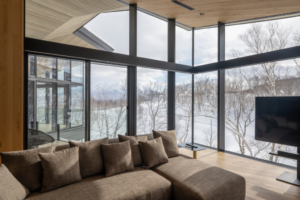
Inside, its minimalist aesthetic is warmed by timber accents, plush furnishings, and an open-plan living space that’s perfect for après-ski gatherings. Guests can unwind and enjoy the cinematic nights by the fireplace, or simply watch the snowfall in complete privacy, a true embodiment of refined alpine living.
Read also: 8 Best Ski Chalets in Hokkaido For Stylish Snow Holidays
#5 What is Niseko United exactly?
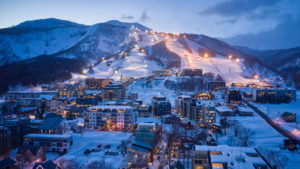
Niseko isn’t just one mountain; it’s a universe of powder, each resort with its own personality, vibe, and view of Mount Yotei. Whether you’re gliding along gentle beginner runs, strapping on for night skiing, or just enjoying the snow-covered landscape, there’s a slice of Niseko calling your name.
From the lively heart of Grand Hirafu and its après-ski scene, to the sleek gondolas and wintry forests of Hanazono, every slope tells a story. Those craving quiet runs can retreat to Annupuri, while Niseko Village offers the perfect midpoint — central, scenic, and effortlessly connected.
Beyond Niseko, Furano’s charm and feather-light snow make it a favourite for those seeking a more serene Hokkaido escape, while Rusutsu is known as a ski instructor’s favourite ski town.
Read also: One, Two, Ski: The Official Opening Dates of Niseko and Furano Ski Resorts
#6 How do you get around in Niseko?
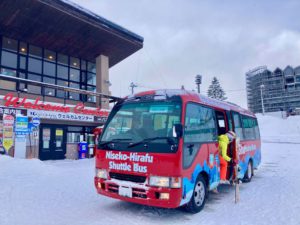
Once you’ve landed in Niseko, the mountain isn’t as remote as it looks, and getting from village to village is part of the experience. Many accommodations offer complimentary shuttles, and the Grand Hirafu Shuttle zips you between resorts in minutes.
For those seeking flexibility, local taxis and apps like TaxiCaller make spontaneous trips effortless. If you’re staying in Hirafu or Hanazono, you can even explore on foot, wandering between cafés, gear shops, and cocktail bars in the soft snowfall. Just make sure your boots are waterproof and grippy; nothing kills the magic of fresh powder like slipping on icy sidewalks.
Read also: 12 Best Soft Serves and Ice Cream To Taste In Hokkaido
#7 What do I need to know about gear rental in Niseko?
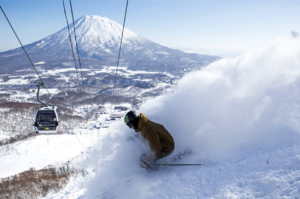
Skiing in Niseko is a dream, and first-timers don’t need to feel intimidated. English-speaking instructors, small class sizes, and patient guidance make learning here surprisingly easy.
Don’t want to lug your skis halfway across the globe? Rentals are simple. YamaSport, Rhythm Japan, and Niseko Sports offer top-of-the-line skis, boards, helmets, and outerwear. Book online in advance, especially for peak months, and take advantage of in-store fitting services for the perfect setup.
We love YamaSport, which has three convenient locations in Skye Niseko, Landmark View, and Yama Shizen, perfect if you’re planning to ski at both Gondola and Family bases. Their gear is well-maintained and constantly refreshed, meaning you’ll always get top-notch skis, snowboards, and outerwear without worrying about wear and tear.
Rhythm Japan is another favourite. Their flagship store sits just minutes from the Hirafu Gondola and Ace Quad Chair, and it’s a local institution for both beginners and seasoned riders. They also have a pretty great retail selection (window shopping anyone?) and a great in-house cafe. At Rhythm, we especially love that you can use the same rental package across multiple resorts — ideal if you’re combining Niseko with Hakuba or Furano in one epic Japan ski trip.
Then there’s Niseko Sports, known for its three strategic locations and thoughtful extras like free overnight storage and equipment transfers between Grand Hirafu and Hanazono — a lifesaver if you’re taking lessons in Hanazono with Niseko International Snowsports School (NISS).
Don’t want to deal with logistics at all? The Luxe Nomad’s Guest Experience can arrange all your rentals ahead of time, from your boots to your board, so you can head straight from check-in to chairlift.
#8 How do I book ski lessons in Niseko?
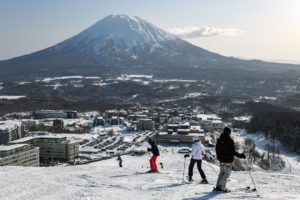
Skiing in Niseko is a rite of passage, and there’s no better place to learn. Whether you’re a first-timer, a rusty intermediate, or an expert fine-tuning your technique, the local ski schools here cater to all skill levels (and all languages!).
We love GoSnow, Niseko’s only international ski school, offering priority lift lane access, meaning less waiting and more time shredding. Their private learning areas and dedicated children’s zones make it an excellent choice for families. Lessons are available in English, and group or private sessions can be booked online ahead of your trip.
Over in Hanazono, Niseko International Snowsports School (NISS) is another favourite, known for its family-friendly approach and multilingual instructors (English, Japanese, French, Spanish, Portuguese, and more). They’re pros at creating safe, supportive, and fun learning environments, especially for kids just finding their snow legs.
If you’re unsure which side of the mountain to base yourself, don’t worry. The Luxe Nomad Guest Services team can help match your accommodation with your chosen ski school and sort everything before you arrive.
#9 What is the dining and après-ski scene like in Niseko?
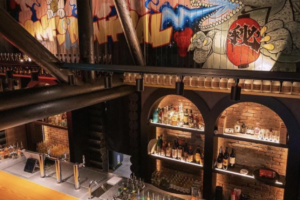
Niseko is, without a doubt, a food lover’s paradise. From Michelin-star-level kaiseki to hearty bowls of ramen (or soup curry) after a day on the slopes, the dining scene here evolves every season, and tables book up fast.
This season, we’re looking forward to Niseko Confidential’s second season and its two new sister outlets: Tepache and AóRA. Another restaurant we’re really excited about is MASONRY. Japan. Bali’s well-loved restaurant is setting up its first international outpost at ski-in, ski-out hotel, Niseko Kyo. We’re looking forward to inventive cocktails like the pomegranate-laced margarita, paired with wood-fired plates showcasing Hokkaido’s fresh produce.
If you feel like eating at home, there’s always the no-fail konbini run (Seicomart has hot food and even champagne) or an elevated takeaway from Ezo Seafoods (think: ultra-fresh sushi and sashimi). The ultimate splurge, however, is booking an in-house dining experience like the one by Niseko Black. They offer a seven-course Western-style omakase experience, curated by their chef. Each course builds in complexity — from delicate seafood to rich, savory A5 Wagyu — blending umami-forward flavour with European techniques.
Our best food advice? Once your trip is confirmed, start locking in your dinner plans. The village is full of cosy, intimate spots that fill up weeks in advance. And if that sounds like too much admin, The Luxe Nomad Guest Experience Team can help.
Read also: New Niseko Restaurant: MASONRY. Japan Debuts in Hokkaido
#10 What else is there to do besides skiing or snowboarding?

Niseko has a trove of activities for non-skiers, from snowmobiling with a view of Yotei-san to even horse-riding in the snow (yes, it’s as romantic as you think). After a day out in the cold, there’s nothing like soaking in an onsen. Bathing in the mineral-rich hot spring waters is a wellness ritual in Japan, something that you’ll relish and want to do at home. After the heat, enjoy having a cold drink after. Contrast therapy at its finest!
If you’re dreaming of having an onsen of your own, we suggest staying at Niseko Kyo, The Vale Rusutsu, Kazahana, and our brand-new chalet, Aki.
Read also: Everything You Need To Know About Onsen
Last note: Money Concerns
 When it comes to money, Japan still loves its cash. While Niseko leads the way in the country’s slow shift to cashless payments, you’ll still find plenty of places that only accept yen. Most hotels and restaurants take Visa, MasterCard, and Amex, but smaller cafés, taxis, and convenience stores may not.
When it comes to money, Japan still loves its cash. While Niseko leads the way in the country’s slow shift to cashless payments, you’ll still find plenty of places that only accept yen. Most hotels and restaurants take Visa, MasterCard, and Amex, but smaller cafés, taxis, and convenience stores may not.
Luckily, ATMs at convenience stores (or konbinis) like 7-Eleven, Lawson, and Seicomart accept international cards and are scattered throughout the area, so it’s easy to withdraw what you need.
WanderLuxe Tip: Bring yen in smaller denominations. It makes things smoother for local eateries, and it’s always polite to pay the exact amount (no tipping is expected in Japan).

